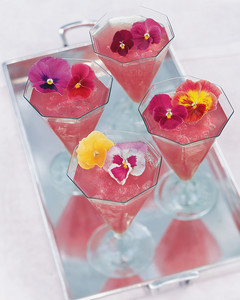
A few years ago, a major lifestyle magazine—which I won’t name—featured a glistening Thanksgiving turkey on the cover. Decorative berries and leaves were tucked around the bird. How luscious.
Not.
Turns out the decorations were toxic to humans. The retraction was swift. No readers ate the fixings. But if the magazine crew had checked with a garden expert like Maggie Stuckey, they would have found many acceptable alternatives. Maggie loves adding flowers, leaves, and berries from edible plants. She’s the co-author (with Rose Marie Nichols McGee) of The Bountiful Container Garden, now in its ninth printing.
So, in memory of that past magazine turkey blooper, I have two questions for Maggie. The first—how do you confirm whether a plant, or parts of a plant, can be eaten?
“Start with a trustworthy list of safe plants,” she says, “like those on the website of the Toronto Botanical Garden.” She also favors other knowledgeable garden writers like Cathy Wilkinson Barash, Rosalind Creasy, and Ellen Zachos. And for added safety, “Make sure you’re using blossoms that have not been treated with poisonous chemicals,” Maggie notes. “Fully organic is ideal.”
And my second question—how do you decide which ones to use in your cooking?
“Taste them!” Maggie says. Identify the primary flavor of each one. “I encourage cooks to imagine what sort of dish that taste would complement.”
Maggie suggests two broad flavor categories:
sweet/floral – violets, rose, pansy, tulip, dianthus, lavender, lilac
herbal/tangy – gem marigold, nasturtium, chives, chrysanthemum, begonias, daylily, sunflowers
Here are some of her favorite recipes. Many of the plants used here will extend their bloom season when overwintered in a greenhouse or sunny room.

Easy Nasturtium Appetizer: Cut flower petals into small pieces. Mix into softened cream cheese, thinned with a dollop of crème fraiche. Let sit several hours to blend flavor. Spread on crackers or toasted baguette slices. Add whole blossoms to the serving platter, both for decoration and a hint of the spicy peppery taste.
Tuberous Begonia Rice Pilaf: For a rich lemony flavor, cut begonia petals into thin ribbons. Substitute for lemon zest in your favorite pilaf dish. Maggie says, “You’ll have gorgeous bright orange colors.”
Clove Pinks in Sautéed Apples: Pull apart the clove pink flowers. ((These Dianthus get their name from their clove flavor.) Snip off the bitter white heel at the base of each petal. Sauté apple slices in butter. Sprinkle with sugar and a dash of salt. Fold in the flowers.
Pansies in Trifle: This layered fruit/cake/pudding concoction is usually served in a clear glass bowl. Before adding layers, press colorful pansy blossoms along the inner sides of the glass.


